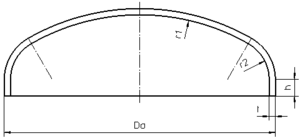Pressure Vessel Head Shapes
Hemispherical
Hemispherical, half-sphere is the ideal shape for a vessel head. This is because forces are spread out equally across the head. The radius of the hemisphere is constant as opposed to an elliptical head. The radius is equal the the radius of the shell that it attached to.
2:1 Elliptical
Also known as an ellipsoidal head and is the most common type of head. Elliptical heads are specified by the ratio of the depth to the diameter. A 12" diameter 2:1 elliptical head is 3" deep.
 Torispherical
Torispherical
These heads are sometimes referred to as flanged and dished heads after the manufacturing process. The geometry of the head is composed of the crown or dish radius, the major portion of the head. The dish radius (r1) is a fixed radius whose size id dependant on the type of head. The knuckle radius (r2) is the radius to the outer edge. The deeper the head is (h), the more expensive the head is to manufacture. This type of head has good drainage when used in the vertical position.
Conical
Conical heads possess more inherent strength than flat heads. Conical bottoms, depending on the angle of the cone, provide excellent bottom drainage. Placing a nozzle at the bottom of a conical head will allow for solids and precipitate to immediately get flushed out. The ASME code limits conical heads without a knuckle radius to a maximum included half angle of 30 degrees. The conical angle is specified differently depending on the manufacturer, some specify the included angle while others the angle of the cone in reference to the tangent line of the head.
Flat
This is a head consisting of a toroidal knuckle connecting to a flat plate. This type of head typically is not used on pressure vessels since it is inherently very weak.

